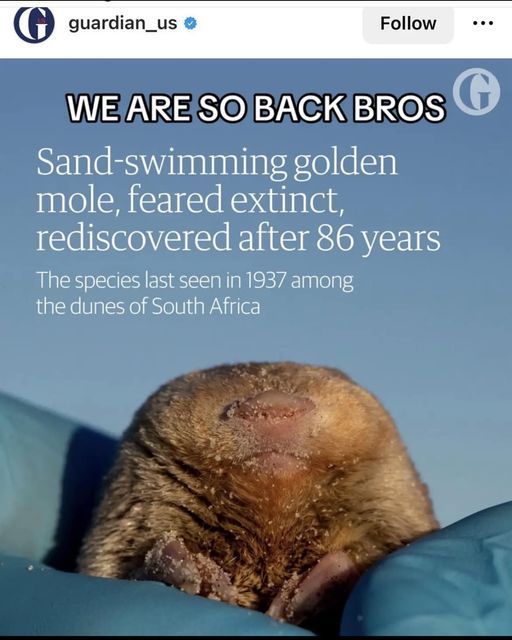#golden mole
Text
I love all animals so much but I can't lie there's a special place in my heart for the Golden Mole

Look at him.
He has no eyes. His face is an ear. He's iridescent. What can't he do
#Golden mole#Animals#Not a rodent but phobias don't make sense so tagging#Rodents#Mole animal#I love him#Not a lie too btw he legit cannot see there are no eyelids on that face
6K notes
·
View notes
Text
golden mole

golden mole facts:
21 species in the family
taxonomically distinct from the true moles, but functionally similar, having very dense fur and inconspicuous eyes and ears
can switch off thermoregulation when inactive (torpor)
desert-dwelling species such as grant's golden mole dip their heads in the sand to listen for termites living under grass clumps
3K notes
·
View notes
Text
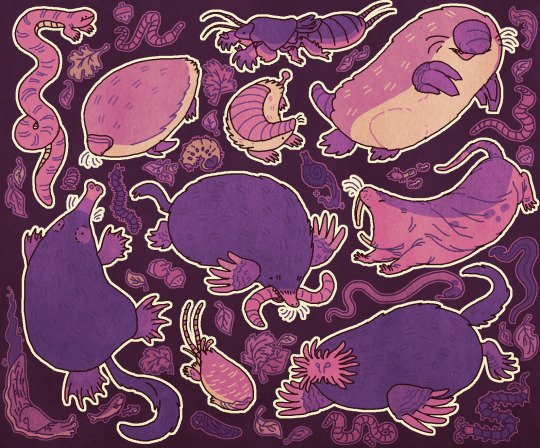
🪱🪱🪱 HAPPY MOL DAY 🪱🪱🪱
#happy LATE mol day but still :)#my art#mole#worm#Mexican mole lizard#mole cricket#mole crab#star nosed mole#desman#marsupial mole#golden mole#pink fairy armadillo#naked mole rat#plus an assortment of underground friends you might see if you were looking for moles#snail#grub#slug#bugs#insects#centipede#millipede#termite#planarian#crown snake#you would not believe how hard it is to find refs for some of these guys- ended up basically guessing for marsupial and golden mole claws
845 notes
·
View notes
Text

455 notes
·
View notes
Text


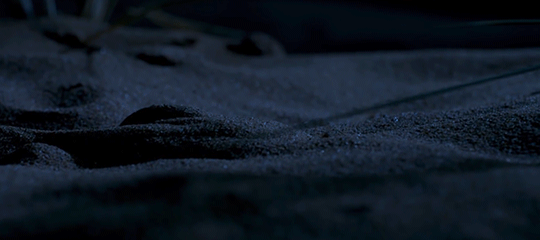

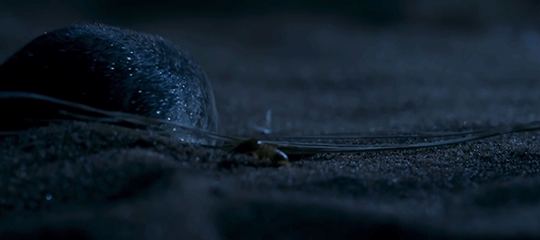
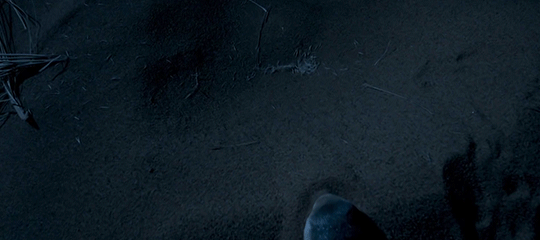
"The golden mole is completely blind, but there's nothing to see underground anyway. Instead it has superb hearing. Its entire head acts as an amplifier that picks up vibrations through the sand. So to locate prey on the surface of the dunes it has, paradoxically, to thrust its face into the dune."
David Attenborough for BBC
638 notes
·
View notes
Text

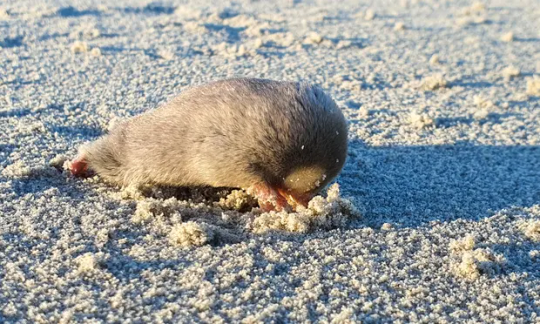
Back from the brink: sand-swimming golden mole, feared extinct, rediscovered after 86 years
Border collie Jessie sniffs out elusive species last seen in 1937 among dunes of South Africa
An elusive, iridescent golden mole not recorded since before the second world war has been rediscovered “swimming” in the sand near the coastal town of Port Nolloth in north-west South Africa.
The De Winton’s golden mole (Cryptochloris wintoni), previously feared extinct, lives in underground burrows and had not been seen since 1937.
It gets its “golden” name from oily secretions that lubricate its fur so it can “swim” through sand dunes. This means it does not create conventional tunnels, making it all the harder to detect...
Read more: https://www.theguardian.com/environment/2023/nov/30/back-from-the-brink-de-wintons-golden-mole-feared-extinct-rediscovered-after-86-years-aoe
251 notes
·
View notes
Text

happy comfort day.
55 notes
·
View notes
Text
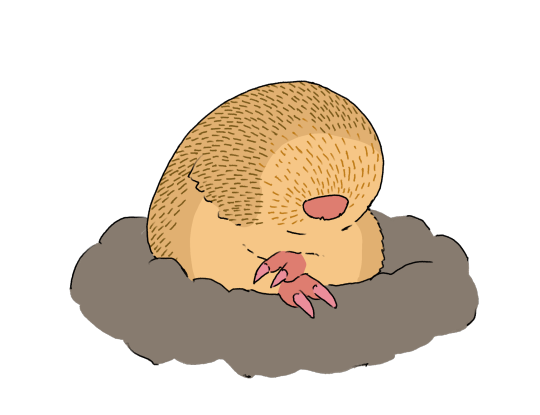
Can i interest you in a golden mole?
They live in sub-saharan Africa and have enlarged ear bones to help them sense worm vibrations
#art#my art#mole interest#mole#golden mole#worm vibrations sounds like some conspiracy theory#the worm vibrations are going to give your kids adhd!! or something lol
112 notes
·
View notes
Text

Very happy about the man of the hour.
63 notes
·
View notes
Text

new Centaurworld OC dropped, he's a moletaur based on golden moles because they're such little creechers
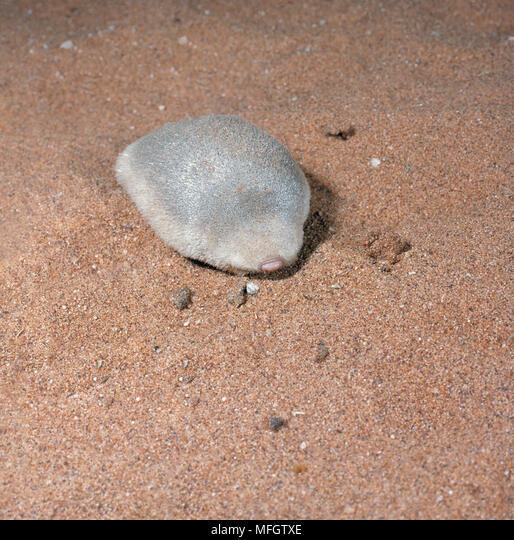

thanks to a suggestion on Discord his name is Golbert
70 notes
·
View notes
Text
COOL ZOOLOGY STORIES OF 2023
Happy New Year! At the start of 2022 I put together a list of some cool zoology-related news stories from 2021, and after... kind of forgetting to put a list together for 2022, I wanted to do the same for 2023. Here are some of my favourite animal-related news stories from the past year (plus one plant-related story, as a treat.)
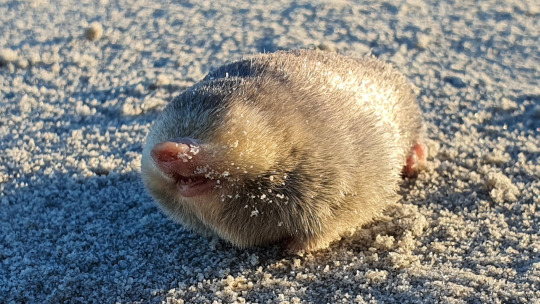
An elusive little mammal was spotted for the first time in nearly a century
Species Concerned: De Winton's Golden Mole (Cryptochloris wintoni)
Family: Golden Mole Family (Chrysochloridae)
Source(s): here and here
A small, superficially mole-like animal seemingly found only in the area around Port Nolloth, South Africa, De Winton’s Golden Mole has long been feared to be extinct due to a total lack of confirmed sightings since 1937. This changed in November of 2023, when (after years of extensive searching) a De Winton’s Golden Mole was found alive for the first time in 87 years, and was photographed for the first time ever.
Though similar to moles in both appearance and behaviour, golden moles are actually part of a separate and only distantly related group of mammals known as Afrosoricidans (alongside tenrecs and otter shrews) that have independently developed mole-like bodies to exploit a similar ecological niche – with massive, shovel-like front paws, short limbs, protective “shields” of toughened skin on their heads and non-functional eyes covered by skin to protect them from irritation, members of this family are adapted to burrowing, and in most cases will spend their entire lives underground unless disturbed. Due to the scarcity of sightings very little is known about the biology of De Winton’s Golden Mole, but based on its sandy coastal habitat and the behaviours of its closest relative, the Van Zyl’s Golden Mole (Cryptochloris zyli) it is likely that members of this species live solitary lives and use their digging abilities to “swim” through sand, preying on insects and small vertebrates which they detect using unique structures in their inner ears that are highly sensitive to vibration.
In addition to conventional habitat surveys within De Winton’s Golden Mole’s presumed range, the team responsible for this species’ rediscovery also utilized several newer or more unusual strategies to search for their focal missing mammal, including thermal imaging to detect underground body heat and the testing of soil and sand in the area for eDNA (tiny amounts of genetic material that organisms leave in water, soil and on other surfaces, giving insight into which species are found in an area without having to actually spot them.)
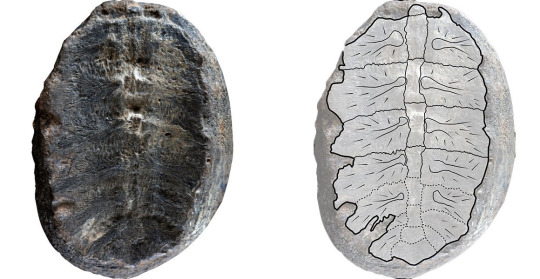
An "ancient plant" turned out to be a baby turtle
Species Concerned: "Turtwig" Cretaceous Turtle
Family: Unknown
Source(s): Here and Here
In 2003, a priest and fossil collector named Gustavo Huertas identified what he believed to be the fossilised remains of a tiny plant of the extinct genus Sphenophyllum in cretaceous-era rocks near Villa de Leyva, Columbia, and named the new species Sphenophyllum colombianum. Huertas' find was unusual in that it dated to the early Cretaceous period (making it over 100 million years younger than other Sphenophyllum species, the last of which are believed to have gone extinct in the late Triassic period,) and it was the fossil's unusual age that drew the attention of Fabiany Herrera, a curator of plant fossils at the Field Museum of Natural History in Chicago, USA and Héctor Palma-Castro, his student. After taking an interest in the fossil the two travelled to the Universidad Nacional de Colombia in Bogotá, Columbia where the fossil was held in order to inspect it, and after realising that its features were unlike other Sphenophyllum species and consulting a vertebrate palaeontologist, Edwin-Alberto Cadena, they eventually came to realise that what Huertas had found was not a Sphenophyllum species, or event a plant - what had originally been interpreted as the stems and leaves of a plant were actually the ribs of a very small, and likely very young, prehistoric turtle.
The ribs of turtles are located on the upper surface of their shells, where they form a sort of "roof" that strengthens the shell's outer carapace. Newly hatched turtles have fragile bones and shells that are easily broken beyond recognition during fossilization, so finding the well-preserved remains of a young turtle (estimated to be less than 1 year old when its bones were buried) is very rare. The discovery of the true identity of "Sphenophyllum colombianum" was published (here) in early December 2023, and as such the newly discovered turtle fossil has yet to be given a new name. Instead, it has been affectionately dubbed "Turtwig", after the half-plant-half-turtle gen 4 starter Pokemon, until it can be formally reclassified.
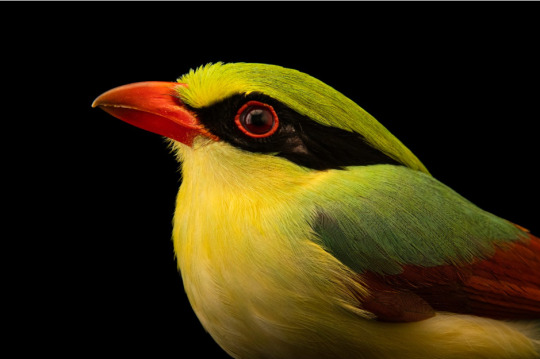
The Indochinese Green Magpie became the Photo Ark's 14,000th species
Species Concerned: Indochinese Green Magpie (Cissa hypoleuca)
Family: Crow Family (Corvidae)
Source: Here
The National Geographic Photo Ark is an ambitious project led by Canadian photographer Joel Sartore which aims to photograph every species held in captivity worldwide, providing high-quality images of often relatively obscure species and raising awareness of each species involved. In 2021 the Arabian Cobra became the 12,000th species added to the ark, in 2022 the Spoon-Billed Sandpiper became the 13,000th, and as of May 2023 the Indochinese Green Magpie has become the 14,000th species Sartore and his team have photographed.
Unlike the vast majority of crow species, the 4 species in the genus Cissa, known collectively as green magpies, are brightly coloured, largely carnivorous birds with vivid green feathers and bright red beaks and feet which are thought to aid them in camouflaging against the leaves and bark of the dense, humid forests they typically inhabit. The Indochinese Green Magpie, which is found in densely forested areas from central China to southern Cambodia, is one of the most common green magpie species, but is still believed to be experiencing a decline in population size due to the intense demand for members of this species in the illegal wildlife trade, both for their feathers and to be kept as illegal pets. The model for Sartore's photo, a female named Jolie, was herself found in a suitcase that was intercepted while being smuggled through the Los Angeles International Airport, and is now kept Los Angeles Zoo and Botanical Gardens. The team behind the Photo Ark have expressed hopes that Jolie's picture and story will help to raise awareness of the harmful effects of the illegal exotic pet trade and its prominence within the USA. On a happier note, the photo also seems to show that Jolie is now doing well - green magpies kept in captivity have been known to sometimes take on a duller colouration due to a lack of carotenoids in their diet, so her natural green feathers are an indicator of good health.

A very rare, very weird plant was rediscovered after 30 years
Species Concerned: Thismia kobensis
Family: Burmannia Family (Burmanniaceae)
Source(s): Here, here and here
In 1992, a bizarre-looking plant was found growing near the city of Kobe in Japan; pale and partially transparent without any leaves or chlorophyll, it was a member of the genus Thismia and was notable for being found further north than any other Asian species in the genus to date. A single plant was collected and taken to the Museum of Nature and Human Activities in the nearby city of Sanda, and in 2018 extensive examination of this single preserved plant led to it being determined to be a previously undocumented species, Thismia kobensis. This discovery led to surveys being dispatched to the area where the species was originally discovered in hopes of gathering additional samples and learning more about T. kobensis in the wild, but after surveys of the area were unable to find any remaining individuals, and following the discovery that the site from which the original sample had been collected had been converted into an industrial complex since the 1990s, the species was feared to have gone extinct. In February of 2023, a team of researchers led by Kobe University's Professor Kenji Suetsugu announced the first documented sighting of Thismia kobensis in 31 years, having found a small population growing in Sanda, not far from the museum that holds what had long been the only known specimen of the species and roughly 30km (18.6 miles) from the site at which the species was originally discovered. Their publication can be read here.
Thismia species, also known as fairy lanterns, are almost alien-looking plants that, as mentioned previously, lack chlorophyll and do not carry out photosynthesis, instead gaining nutrients parasitically by connecting their roots to the hyphae of typically mutualistic fungi and extracting nutrients from both the fungus itself and from any other plants that it has connected to (making it a mycoheteroph, much like the slightly better-known ghost plant/ghost pipes.) This unusual lifestyle likely developed as an adaptation to allow members of this genus to survive in forests with dense canopies that block out sunlight, but also makes them highly sensitive to environmental change - in order for an area to support a healthy population of Thismia kobensis, it must also support healthy trees and healthy soil fungi. As the original preserved 1992 specimen of T. kobensis was long dead and slightly damaged, its rediscovery also allowed Suetsugu's team to further study the species, leading to a surprising conclusion - genetically and anatomically, Thismia kobensis seems to have more in common with Thismia americana (the only known North American species of Thismia, which was last sighted in 1916 and is similarly feared extinct) than to any other Asian Thismia, possibly suggesting that T. kobensis and T. americana are descended from common ancestors that spread either from Asia to the Americas or vice versa during a time when their ranges were connected by a land bridge.
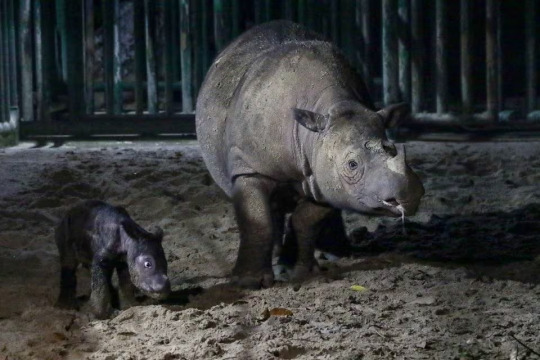
Important progress was made in saving the Sumatran Rhinoceros
Species Concerned: Sumatran Rhinoceros (Dicerorhinus sumatrensis)
Family: Rhinoceros Family (Rhinocerotidae)
Sources: Here and here
Distinguished from the other 4 rhinoceros species by its relatively small size, 2 horns and short black fur (which is barely present in adults, but very prominent in calves) the Sumatran Rhinoceros is one of the rarest mammals on earth, with an estimated population size of roughly 30-80 individuals. Having had its numbers drastically reduced by poaching, habitat loss and extreme weather events, the species is now threatened by its own small population size - found only in tiny scattered populations across Sumatra and Borneo, it is now extremely difficult for wild members of this species to find mates, and where mating does occur such a small population size considerably limits genetic diversity, increasing the risk of calves being born with health complications. To combat this numerous efforts to breed Sumatran Rhinoceroses in captivity have been developed, and as of November of 2023 the results have been promising; last year saw the birth of 2 Sumatran Rhinoceros calves at the Way Kambas National Park in Lampung, Sumatra.
The youngest of 2023's calves, a male, is the son of a female named Delilah who was herself the second calf to have ever been born at the park's Sumatran Rhinoceros Sanctuary (a site where members of this species are cared for and protected from illegal poaching while breeding.) This marks the first-ever instance of a captive-born Sumatran Rhinoceros giving birth, and therefore represents a key step in establishing a healthy captive breeding population of Sumatran Rhinoceroses to help preserve and increase the genetic diversity of wild populations. The calf's father, named Harapan, was born in Cincinnati Zoo in the USA, and it is hoped that the careful incorporation of the handful of Sumatran Rhinoceroses held in zoos into wild breeding programs can further help to increase the species' genetic diversity in the future. While extensive action is still needed for the Sumatran Rhinoceros to be saved, the park's work this year represents a significant step towards the species' conservation.
--------------------------------------------
Have a great new year!
#Happy new year!#2023#2024#zoology#biology#mammalogy#paleontology#botany#ornithology#conservation#animal#animals#plant#plants#wildlife#turtwig#de winton's golden mole#golden mole#golden moles#Indochinese green magpie#green magpie#green magpies#Thismia kobensis#Thismia#Sumatran rhinoceros#rhinoceros#rhinoceroses
33 notes
·
View notes
Text
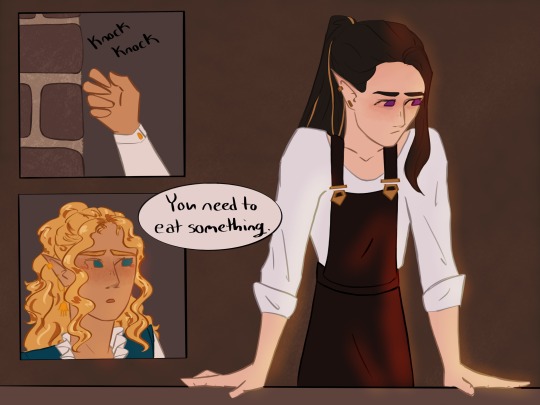
Requested from this list by the lovely @yellow-faerie!
53 notes
·
View notes
Text

what if i make a character who's a golden mole but she enjoys wearing cat-ear headphones…
68 notes
·
View notes
Text

215 notes
·
View notes
Text

its dangerous to go alone, take this.
44 notes
·
View notes
